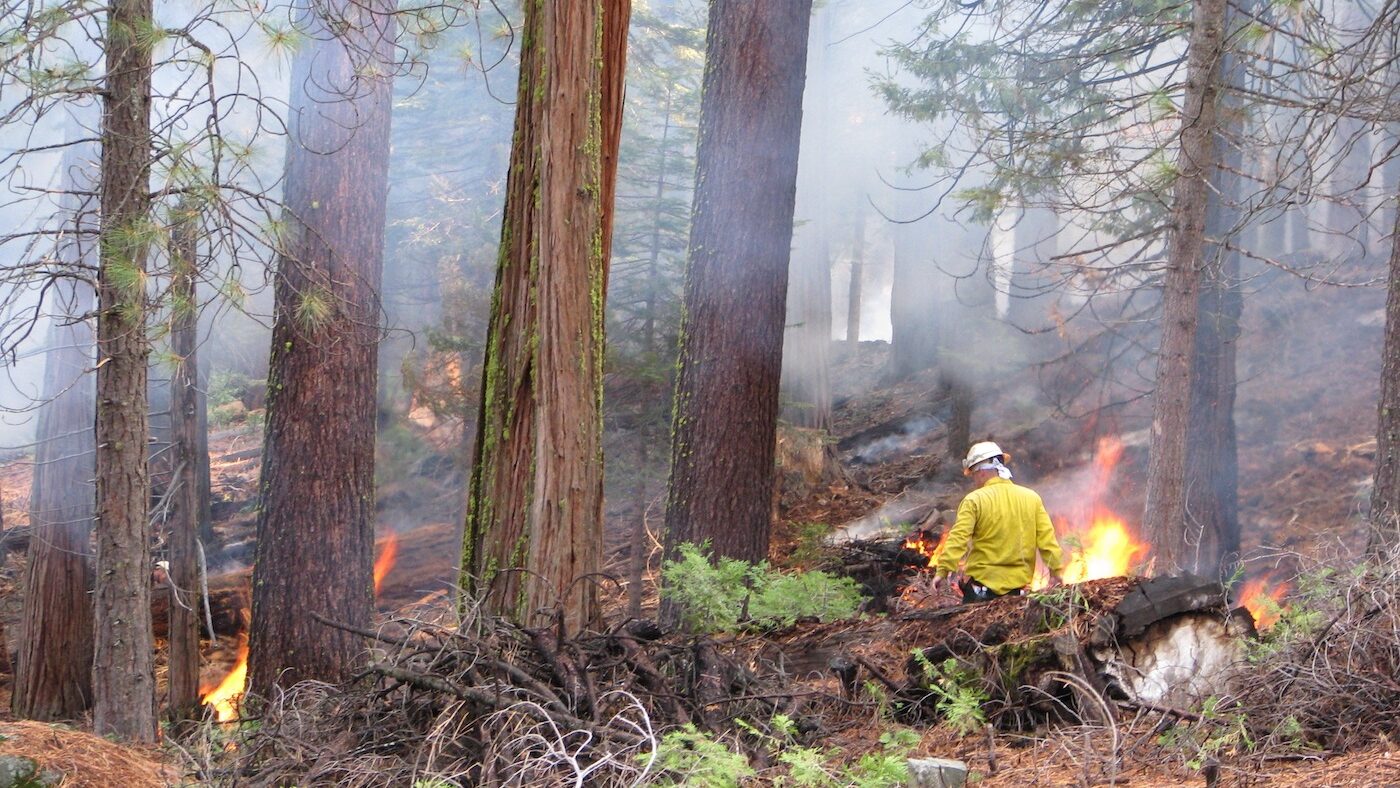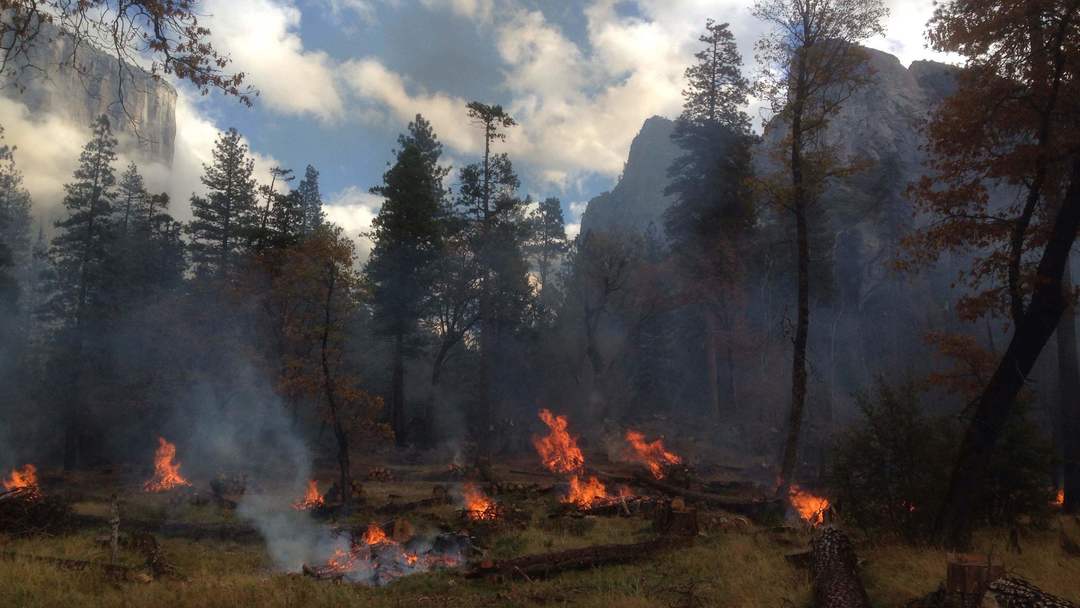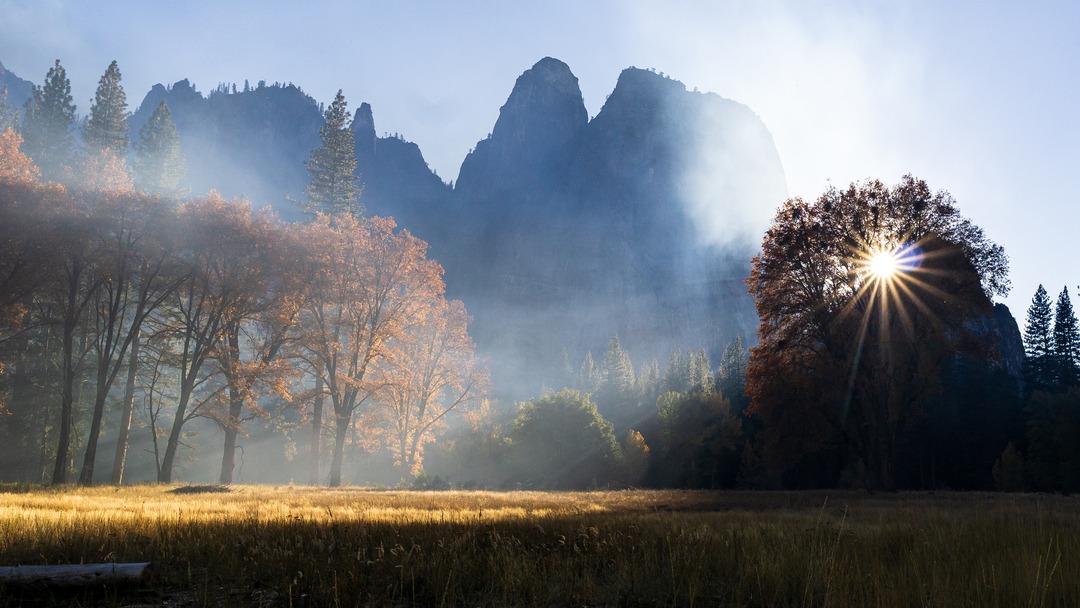Yosemite is a fire adapted landscape. Fire in Yosemite — prescribed burns and wildfires — can happen at any point in the year. It is helpful to know fire facts, resources, and where to look for current updates. Use this blog to broaden your knowledge of fire in Yosemite and to better prepare for upcoming trips.
Fire in Yosemite: Quick Links
Yosemite National Park’s Fire News webpage — your go-to for regular fire updates from the National Park Service, including:
- Yosemite fire map
- Current fire activity and restrictions
- Smoke management and air quality
- Climate change, fire ecology, history and management in the park.
Most major fires in California and across the United States are mapped and updated on either InciWeb (for fires on federal public land, including significant fires in Yosemite) or Cal Fire (for fires in state-managed areas).

A firefighter in yellow walks among small fires in a young forest in Yosemite National Park.
Fire can be devastating…
Like many places around the world, California has faced massive, historic, terrifying wildfires. Since the early 2010s, records have been shattered again and again. Entire towns have been consumed by fire, thousands of families have lost their homes, vital wildlife habitat has been destroyed, and air quality plummets during large fire incidents.
Yosemite Conservancy staff members and volunteers, like many others across our state and our nation, have felt the devastating impacts of these fires. Wildfire can be disruptive, frustrating, and heartbreaking.
…and yet, it is critically important.
Fire is a critical and quintessential part of Yosemite’s ecosystems, as is true throughout most of California.
This landscape adapted to wildfire, becoming both resistant to it and dependent on it. For example:
- Mature giant sequoia trees are extremely resistant to low-intensity fire. Their thick trunks are devoid of vulnerable branches at the bottom. Their thick bark is flame-resistant. Their tiny, flake-like seeds are released from their cones when exposed to high heat. And fire burns up dead and downed trees and brush, which allows those small seeds to reach the topsoil below, instead of blowing away in the wind.
- In a landscape where water resources have always been limited, wildfires kept fast-growing conifers at bay from wetland habitats. Low-intensity fire kills young, fast-growing lodgepole pine and other conifers while usually leaving mature trees intact. This also preserves meadows and wetlands from encroaching trees, which are important biodiversity hotspots that are essential within Yosemite’s hydrological systems.
- Yosemite is a haven for diverse flora and fauna, including many rare, endemic plant species that emerge following fire. For this reason, these rare flowers are colloquially called “fire followers.”
These are just a few among many examples of the important ecological benefits of wildfire, which plays a crucial role in healthy forest and meadow ecosystems. Fire in Yosemite benefits species from black oak trees to spotted owls and so many more. Learn more about contemporary flora and fire management in the recent Conservancy article “Fighting Fire with Fire.”

Pile burning takes place during a prescribed burn in Yosemite Valley.
Cultural burning, the precursor to prescribed fire
For many millennia, fire has been integral to many Indigenous peoples’ ways of life. Native Americans, Alaska Natives, and Native Hawaiians used fire to clear areas for crops and travel, to manage the land for specific plant and animal species, to hunt game, and for many other important uses.
Throughout California, Indigenous nations have used fire for thousands of years as a tool to steward the land, and still do so today. Cultural burns passed down through generations have benefited both land and people, by improving soil quality and spurring growth of certain plant species, creating a healthy and resilient landscape. Fire was a tool that promoted ecological diversity and reduced the risk of catastrophic wildfires.
For over 4,000 years, American Indians have relied on Yosemite Valley’s meadows and oak woodlands for food, medicine, basket materials, string, and shelter. Research on mud cored from Yosemite Valley showed a marked increase in ash deposits after people began living in Yosemite Valley.
Learn more about cultural burning at national parks and historic places across the country in NPS article “Indigenous Use of Fire.”
Visiting Yosemite’s Fire-prone Landscape
Wildfire activity can heavily impact the visitor experience in Yosemite National Park — especially in the summer and fall (“fire season”). To make the best of your trip and stay safe in the process, keep these three things in mind:
Active Wildfires
Fires actively burning in or near Yosemite are monitored closely. Some active wildfires, are barely noticeable to the majority of the public and other fires will have a greater impact on visitors’ experience.
Depending on status, location, and smoke output of an active fire, a part or all of the park may close for a period of time. This is done to protect visitor safety (see additional details on smoke and air quality below) and to ensure that firefighters have the space and resources to manage the fire. Information about active wildfires in the park can be found on the Yosemite National Park’s Fire News page.
Prescribed Burns
According to Yosemite National Park, “Prescribed fires are used to mimic the natural presence of fire in an ecosystem. They are ignited under optimal conditions by qualified park staff, and they remove dead and overgrown vegetation that could contribute later to a more severe fire.” It’s important to remember that:
- Prescribed burns generally happen outside of Fire Season – early in spring and later in fall, especially during wetter years. Information regarding the history and importance of prescribed burns in Yosemite can be found on the park’s webpage,“Managing Wildfire, Prescribed Fire, and Fuels.”
- Information about active and upcoming prescribed burns in the park can be found on the NPS.gov Yosemite fire news page. You can also follow Yosemite Fire and Aviation on major social media platforms for updates regarding prescribed burns.
Smoke Management and Air Quality
Smoke from wildfires — within the park and even across the country — can degrade local air quality, reduce visibility in the park, and pose a potential health concern. If you, or someone in your group, a low tolerance to smoke, or begin to feel unwell, take these measure to reduce exposure in places where smoke from wildfires is occurring:
- Stay indoors as much as possible and avoid physical exertion, especially sensitive individuals.
- Close windows, doors, and outside vents when it is smoky. Use a fan or air conditioner to recirculate the air.
- Drink lots of water, eat a balanced diet, and get adequate rest. Good health strengthens your immune system.
Learn more about air quality and view live air quality data for Yosemite National Park locations.

Light reflects off of smoke in Yosemite Valley.
Fire buzzwords, defined
- SEVERITY is used to describe a wildfire’s impact to vegetation. A fire is considered high severity if it destroys a lot of trees and other flora, while a low severity fire has a minimal impact on the existing vegetation in the burn area.
- INTENSITY refers to the physical temperature of a wildfire. A fire that burns very hot is considered high intensity. Low intensity fires are the inverse.
- CATASTROPHIC is a value-based term, and it is often misused. A catastrophic wildfire burns a giant sequoia grove, or the homes in a community. If something that we as humans value is lost in a fire, that fire can be considered catastrophic.
- CONTAINMENT is defined by the National Wildfire Coordinating Group as “the status of a wildfire suppression action signifying that a control line has been completed around the fire, and any associated spot fires, which can reasonably be expected to stop the fire’s spread.”
- PRESCRIBED BURNING, or prescribed fire, is defined by the U.S. Forest Service as “the controlled application of fire by a team of fire experts under specified weather conditions to restore health to ecosystems that depend on fire.”
